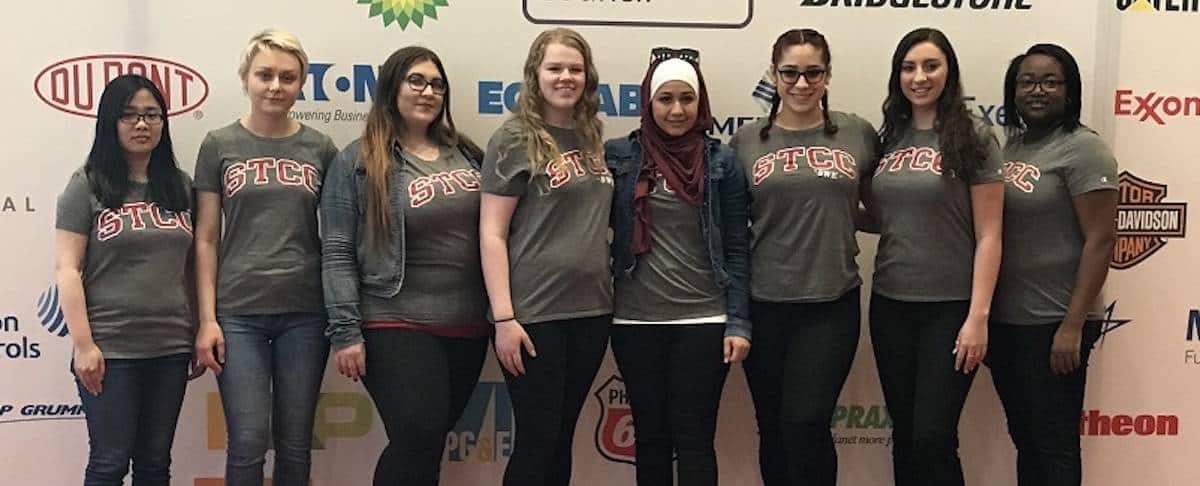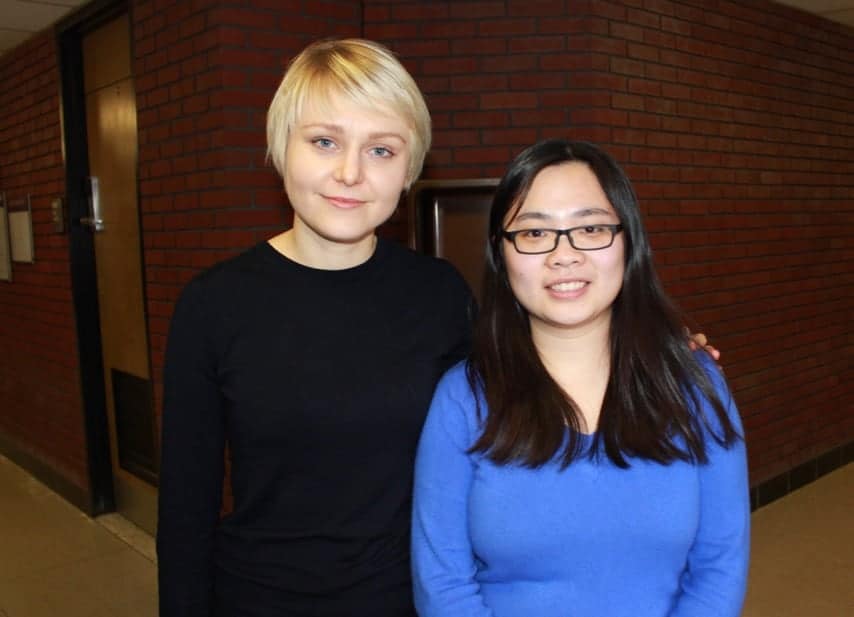This news release is from Springfield Technical Community College in Massachusetts.
Student Clair Yiting Gu was nearly 2,000 miles from Springfield Technical Community College, but she felt at home at the Society of Women Engineers Annual Conference.
Gu, of Springfield, was one of eight STCC students who traveled to Austin, Texas, for the SWE conference to join 14,000 attendees, including college students, academic women and professional women.
“It’s awesome,” said Gu, a computer science student who spoke from the STCC campus after returning from the conference. “You see a lot of women engineers there. You feel like you are not alone. It’s very exciting.”

Another computer science student who attended, Darya Bandarchuk, of West Springfield, loved the opportunity to meet women who are interested in engineering. “It was great. It was my second time going to a SWE conference. There are not a lot of events like the SWE conference. You get completely immersed in engineering. You get to go to a career fair, which is a great opportunity,” she said.
The conference, which was held in October, is billed as the world’s largest conference and career fair for women in engineering and technology. STCC prepares students for careers in the STEM fields – science, technology, engineering and mathematics.
As a technical community college, but also as a ‘STEMinist’ institution, I am thrilled our students had the opportunity to attend this important conference.Dr. John B. Cook, President, Springfield Technical Community College
“As a technical community college, but also as a ‘STEMinist’ institution, I am thrilled our students had the opportunity to attend this important conference,” said STCC President John B. Cook.
Beth McGinnis-Cavanaugh, professor of physics and engineering at STCC and the SWE faculty advisor, helped raise money to bring a contingent of students and three faculty and staff to the conference. She said STCC was better represented than any other community college in the country.

The conference provided an opportunity to attend workshops and meet with major employers from technology companies such as Google, Amazon and Texas Instruments, among others. STCC students who want to transfer after receiving their two-year associate degree were able to meet with representatives from four-year engineering programs.
STCC students participated in presentations at the conference. McGinnis-Cavanaugh’s presentation focused on a proposal to form a SWE network among the 15 Massachusetts community colleges. STCC staff member Isabel Huff presented on gender stereotypes that can hold women back from pursuing careers in STEM.
“They’re exposed to students from all over the country, mainly from four-year schools,” said McGinnis-Cavanaugh. “They’re also exposed to a lot of professional women and professionals who are there recruiting. They have a huge career fair. They do on-site interviews and resume reviews. For our students, it’s great exposure. They don’t generally have these kinds of opportunities.”
While the employers were mainly looking to hire students graduating with four-year degrees, STCC students received a tremendous opportunity to practice interview skills, obtain feedback on their resumes and chat with professionals in the field, McGinnis-Cavanaugh said. As engineering is still a field dominated by men, most companies are seeking a more diverse workforce and are eager to hire qualified women.
SWE, a national professional society for women in engineering and related STEM fields, supports collegiate sections nationally and internationally. STCC is one of only 14 community colleges in the country affiliated with SWE. The chapter, formed in 2014, comprises about 20 women majoring in engineering and science transfer and engineering technologies.
“It was an unbelievable event, and it was great that the college supported their trip,” McGinnis-Cavanaugh said. “We had at least one student who had never been on a plane before. To have an opportunity to visit a city like Austin, which is a real tech hub, and then be with 14,000 women who are in STEM, is pretty incredible.”
Interested in applying to an engineering or other program at STCC? Visit www.stcc.edu/apply or call Admissions at (413) 755-3333.
About Springfield Technical Community College
Founded in 1967 and located on 35 acres of the Springfield Armory National Historic Site, STCC is a major resource for the economic vitality of Western Massachusetts. As the only technical community college in Massachusetts, STCC, a designated Hispanic Serving Institution and an Achieving the Dream Leader College, offers a variety of career programs unequalled in the state. STCC’s highly regarded transfer programs in business, engineering, liberal arts, science and technology continue to provide the most economical options for students pursuing a four-year degree. With an annual enrollment of more than 7,700 day, evening, weekend and online students, STCC is a vibrant campus rich in diversity.
For more information about STCC, visit www.stcc.edu.
Diversifying STEM: Student Success and Community College Transfer in Engineering and Computer Science in Texas
Community college students are often excluded from conversations surrounding broadening participation in STEM, particularly in the fields of engineering and computer science (ECS). The Society of Women Engineers conducted a study of ECS transfer students in Texas to understand the success of women and minority students on this pathway towards a baccalaureate degree. The findings suggest that greater attention to this pathway could make a significant impact on our ability to diversify the engineering profession. Learn more on SWE’s Research site.





